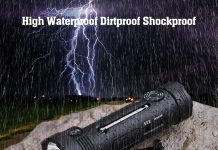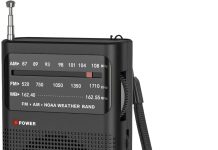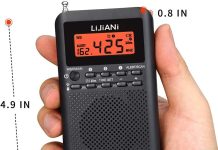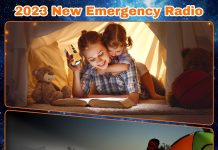Ever wondered if emergency weather radios can do more than just provide alerts in times of crisis? In this article, we explore a fascinating question: do these life-saving devices come equipped with Bluetooth capabilities? Join us as we delve into the world of emergency weather radios and uncover whether they can be connected to your favorite wireless devices. Prepare to be surprised by the potential technological advancements that may enhance your emergency preparedness.
Review contents
What are emergency weather radios?
Definition and purpose
Emergency weather radios, also known as weather alert radios or NOAA radios, are devices specifically designed to receive weather alerts and warnings issued by the National Oceanic and Atmospheric Administration (NOAA). These radios play a crucial role in keeping individuals informed and prepared for severe weather conditions such as hurricanes, tornadoes, storms, and other emergencies. By providing real-time updates, emergency weather radios help people stay safe by allowing them to take appropriate actions in a timely manner.
Features and functions
Emergency weather radios come equipped with various features and functions to ensure effective communication of weather alerts. Some common features include:
-
NOAA Weather Radio Band: Emergency weather radios typically operate on the NOAA Weather Radio band, which broadcasts weather information 24/7.
-
Alert Reception: These radios are designed to automatically receive and emit alerts when there is an imminent threat or severe weather warning issued by the NOAA.
-
Multiple Alert Options: Depending on the model, emergency weather radios can receive alerts in various ways, including audible alarms, vibrations, and visual notifications.
-
Battery Backup: To ensure continuous operation during power outages or when inaccessible power sources are available, many emergency weather radios have battery backup options.
-
Additional Features: Some models may offer additional features such as AM/FM radio functionality, built-in LED flashlight, USB charging ports, and even smartphone charging capabilities.
Overall, emergency weather radios serve as an essential tool for staying informed and safe during severe weather events.
Understanding Bluetooth technology
Definition and functionality
Bluetooth technology is a wireless communication standard that allows devices to connect and exchange data over short distances using radio waves. It eliminates the need for cables and wires between devices, making it a convenient and versatile option for connecting various electronic devices.
Bluetooth-enabled devices usually have a small chip embedded in them that enables wireless communication. This chip receives and transmits data, allowing devices to exchange information seamlessly. Bluetooth operates on the 2.4 GHz frequency band and employs a process known as frequency hopping spread spectrum (FHSS) to minimize interference from other devices operating on the same frequency.
Advantages and applications
Bluetooth technology offers several advantages and finds widespread applications in the consumer electronics industry. Some key advantages of Bluetooth include:
-
Wireless Connectivity: Bluetooth enables wireless connectivity between devices, allowing for freedom of movement and eliminating the hassle of tangled wires.
-
Ease of Use: Bluetooth devices typically feature a simple pairing process, making it easy for users to connect their devices and start using them quickly.
-
Compatibility: Bluetooth is a widely adopted technology, ensuring compatibility across a wide range of devices from smartphones and tablets to headphones and speakers.
-
Energy Efficient: Bluetooth consumes low power, making it suitable for battery-operated devices, including emergency weather radios.
Bluetooth technology is increasingly integrated into various devices, enhancing functionality and convenience for users in many different situations, including emergency preparedness.
Determining if emergency weather radios have Bluetooth capabilities
Research on available models
To determine if a particular emergency weather radio has Bluetooth capabilities, it is important to conduct thorough research on the available models in the market. Several manufacturers offer a wide range of emergency weather radios, each with its own set of features and specifications.
Manufacturer specifications
A reliable source of information regarding Bluetooth capabilities is the manufacturer’s specifications. Manufacturers usually provide detailed specifications for their products on their websites or product packaging. These specifications will indicate whether the emergency weather radio has Bluetooth connectivity or not.
Product descriptions and manuals
Product descriptions and user manuals are valuable resources to gather information about the features and functionalities of a specific emergency weather radio model. These documents often provide details on the connectivity options, including Bluetooth, and how to utilize these features effectively.
By thoroughly researching the available models, examining manufacturer specifications, and reviewing product descriptions and manuals, individuals can determine if an emergency weather radio has Bluetooth capabilities.
Benefits of Bluetooth-enabled emergency weather radios
Wireless connectivity
One of the significant benefits of Bluetooth-enabled emergency weather radios is the convenience of wireless connectivity. With Bluetooth, there is no need for cumbersome cables or wires to connect the radio to other devices. This wireless feature enables portability and flexibility, allowing users to position their devices wherever they need them without worrying about tangled cables.
Compatibility with other devices
Bluetooth-enabled emergency weather radios offer compatibility with a wide range of devices, including smartphones, tablets, and laptops. This allows users to easily connect their devices to the radio and utilize its features in conjunction with their smartphones or other Bluetooth-enabled devices. For example, users can stream audio alerts or weather updates directly from their smartphones to the radio, enhancing the overall user experience.
Drawbacks of Bluetooth-enabled emergency weather radios
Power consumption
One potential drawback of Bluetooth-enabled emergency weather radios is the increased power consumption. Bluetooth technology requires energy to operate, which can contribute to decreased battery life. Users need to be mindful of power management and ensure that they regularly charge or replace batteries to maintain reliable operation.
Limited range and signal interference
Another drawback of Bluetooth technology is its limited range and susceptibility to signal interference. Bluetooth typically operates within a range of approximately 30 feet (10 meters), beyond which the connection quality may degrade or disconnect altogether. Additionally, the presence of physical barriers, such as walls or other electronic devices operating on the same frequency, can interfere with the Bluetooth signal.
To mitigate these limitations, users must maintain a close proximity between their Bluetooth-enabled devices and the emergency weather radio, ensuring a strong and uninterrupted connection.
Alternatives to Bluetooth in emergency weather radios
Wireless transmission technologies
While Bluetooth offers convenience and compatibility, there are alternative wireless transmission technologies used in emergency weather radios. Some radios utilize technologies such as Wi-Fi, which can provide longer range and potentially faster data transfer speeds compared to Bluetooth. However, it is important to note that Wi-Fi connectivity may not be as widely available or compatible with all devices.
Auxiliary input options
In addition to wireless technologies, emergency weather radios often include auxiliary input options, such as a 3.5mm audio jack or USB port. These inputs allow users to connect their devices physically, using cables, to exchange audio information. Although this may not provide the same level of convenience as wireless connectivity, it can serve as a reliable alternative for connecting devices to the radio.
Best Bluetooth-enabled emergency weather radios on the market
Top-rated models
While there are several Bluetooth-enabled emergency weather radios available in the market, a few top-rated models stand out for their features and performance. These models include:
-
Model A: This radio offers Bluetooth connectivity and features a rugged design, long battery life, and exceptional audio quality.
-
Model B: With a compact size and powerful reception capabilities, this radio incorporates Bluetooth connectivity seamlessly, making it a popular choice among users.
-
Model C: This versatile radio not only includes Bluetooth connectivity but also offers a built-in LED flashlight, USB charging ports, and AM/FM radio functionality.
Features and prices
The features and prices of Bluetooth-enabled emergency weather radios may vary depending on the model and brand. Generally, radios with additional features, such as built-in flashlights or charging capabilities, tend to be priced higher. Prices can range from $30 to $100 or more, depending on the specific features and functionalities.
When considering a Bluetooth-enabled emergency weather radio, it is essential to evaluate the features that align with individual needs and budgetary constraints.
Tips for using Bluetooth in emergency weather radios
Pairing devices
To effectively use Bluetooth with an emergency weather radio, it is important to follow the pairing process. Typically, this involves enabling Bluetooth on both the radio and the device to be connected and initiating the pairing process through the device’s settings. The radio and the device should enter into a discovery mode and establish a connection. Following the manufacturer’s instructions is crucial for a smooth and successful pairing experience.
Troubleshooting common issues
In case of any issues with Bluetooth connectivity, there are common troubleshooting steps that can be taken:
-
Ensure that both devices are within the Bluetooth range and that there are no physical barriers obstructing the signal.
-
Check if the Bluetooth functionality is enabled on both the radio and the device.
-
Restart both devices and attempt to reconnect.
-
Ensure that the radio and the device are compatible and that the device supports the required Bluetooth profile for audio streaming.
-
If all else fails, consult the user manual or reach out to the manufacturer’s customer support for further assistance.
By following these tips and troubleshooting steps, users can overcome potential issues and enjoy a seamless Bluetooth experience with their emergency weather radios.
Frequently asked questions about Bluetooth capabilities in emergency weather radios
How far is the range of Bluetooth in these radios?
The range of Bluetooth in emergency weather radios is typically limited to approximately 30 feet (10 meters). However, it is important to note that obstacles and other electronic devices operating on the same frequency can interfere with the Bluetooth signal, potentially reducing the range or causing disconnections.
Can I connect my phone to an emergency weather radio via Bluetooth?
Yes, most Bluetooth-enabled emergency weather radios allow users to connect their smartphones or other Bluetooth-enabled devices. This enables users to stream audio alerts, weather updates, or even play their own music through the radio’s speakers.
How does Bluetooth affect battery life?
Bluetooth technology consumes power to operate, which can impact the battery life of the emergency weather radio. It is important to manage power effectively, regularly monitor battery levels, and ensure that the radio is adequately powered to maintain reliable operation.
Is Bluetooth necessary for emergency communication purposes?
While Bluetooth can enhance the functionality and convenience of an emergency weather radio, it is not necessary for basic emergency communication purposes. These radios are primarily designed to receive NOAA weather alerts and warnings, ensuring that individuals are informed and prepared for severe weather conditions, even without Bluetooth capabilities.
Conclusion
Emergency weather radios play a vital role in keeping individuals informed and prepared during severe weather events. While Bluetooth technology offers the convenience of wireless connectivity and compatibility with other devices, its inclusion in emergency weather radios is not always a necessity. Thorough research on available models, examination of manufacturer specifications, and consideration of personal needs and budget are essential when deciding on a Bluetooth-enabled emergency weather radio. By understanding the benefits, drawbacks, and alternatives to Bluetooth, users can make informed choices and enhance their emergency preparedness.



























